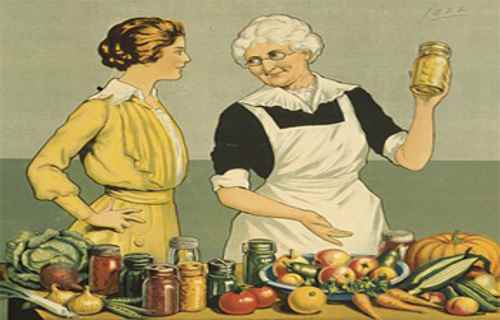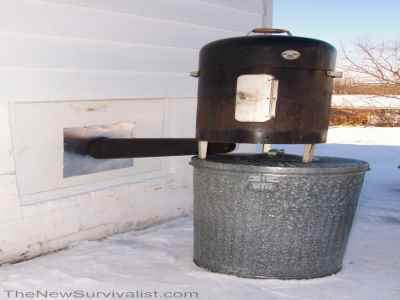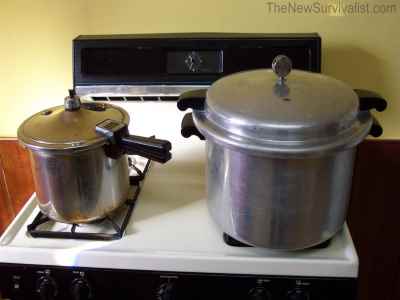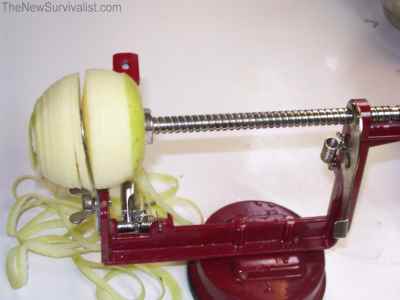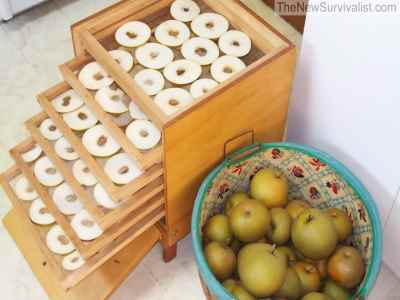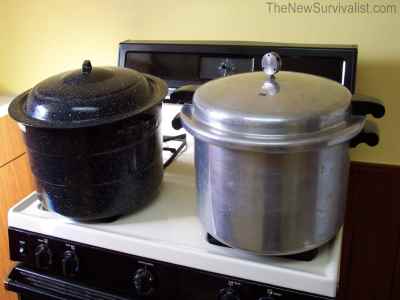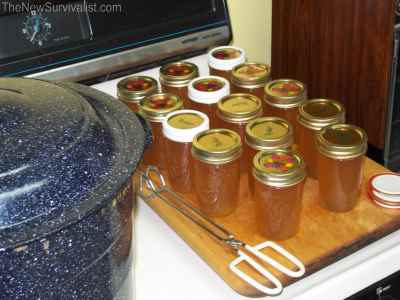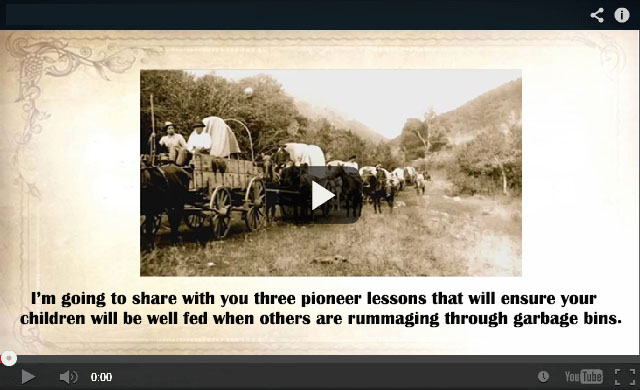The Best Food Preservation Techniques
Food Preservation Techniques
Let’s say that you have just acquired a fresh kill. But it is a large animal (i.e., deer) and there is no electricity, so your refrigerator and freezer are not options. You could build a fire and have a huge barbecue for your entire neighborhood. But you would rather preserve some of this meat to feed your family during the coming months. Well, you can cut the meat into thin strips and dry it or smoke it making jerky. Or if you have a pressure canner and a heat source you can pressure can it. But first you will have to dress it!
Field Dressing
An animal must be field dressed or “gutted” immediately after it is killed—on the spot! Otherwise the meat will go bad very quickly. Even in very cold weather the inside of a large animal will stay warm for a long time after it dies. That heavy coat of fur that keeps the animal warm through the winter also keeps its insides warm for a long time after it has been killed. The digestive systems of all animals contain billions of microorganisms that do no harm when the animals are alive. But when the blood ceases to circulate and the immune system ceases to function, those microorganisms will cause the animal to deteriorate very rapidly. To protect the meat the “guts” have to be removed immediately—in the field—a process known as field dressing. The process is essentially the same for all animals. As an example I will briefly describe the basics of field dressing a deer. There are good videos available at hunting and outdoor stores that describe the process in detail, and a picture is worth a thousand words, as they say, so if you don’t already know how to field dress an animal I would recommend that you acquire such a video and learn how to do it now. One that I recommend in DVD format is Practical Game Processing and Deer Butchering by Timothy Flynn and Gary Zick. Don’t wait until you have a fresh kill on your hands. You will have to act quickly, which means that you will need to know what to do in advance.
If the animal is a buck, first cut off the genitals with a sharp knife. Then slit the underbelly of the animal from the genitals to the ribcage, being careful not to cut the intestines. After your initial incision slip two fingers under the skin to hold the skin up slightly away from the intestines to keep from nipping them. Pull all of the organs out of the body cavity, using your knife to cut away anything that is attached. Save the liver. The kidneys will be located in the flank of the animal. These should be cut away and also saved. Under the rib cage is a muscular diaphragm separating the abdominal cavity (which you just emptied) from the chest cavity. Cut around this diaphragm to remove the chest organs, which consists mostly of the heart and lungs. Reach up inside the chest cavity as high into the throat as possible with your knife, and cut the windpipe and then pull all the organs of the chest out of the animal in one mass. Save the heart. Rinse out the inside of the animal with cold water being particularly careful to wash out any intestinal contents that may have leaked into the carcass, which is now ready for transporting.

Next, make slits behind the Achilles tendons of both rear legs so that you can hang the animal upside down (as seen in the photograph above.) You can hasten the cooling down of the interior of the animal by propping open the internal cavity with a stick so that cold air can get to the inside. The animal may now be skinned and butchered.
During normal times my preferred method for keeping meat is in my freezer. For our purposes, however, I will assume that electricity is not readily available so I will describe two methods of preserving meat which require no refrigeration.
Smoking Meat & Making Jerky
Before refrigeration people relied on salt and smoke to preserve their meat. Most people lived on family farms and the “smoke house” was as familiar as the outhouse. Refrigeration changed the way we did a lot of things, but one thing it did not change was our taste for the flavor of smoked meat. Consequently, smokers are readily available today and recipes abound, including those for smoking your meat in your backyard grill. But one thing that nearly all of these recipes have in common is: the meat is cooked and so the end product will require refrigeration.
To preserve meat that will not require refrigeration a process known as Hard Smoking is required. Hard smoked meat is similar to jerky. It contains a lot of salt, and it is smoked at a low temperature until there is very little moisture left in it. It is kind of like the dehydration method used for fruits and vegetables, but done with smoke and the addition of salt and usually other spices as well. The salt helps preserve the meat by inhibiting the growth of microorganisms. Sometimes the meat is so salty that you may even want to soak it for a few hours before eating it to remove some of the salt. (People used to save this water and reclaim the salt by allowing the water to evaporate.)
The smoked meats and jerky that you buy in stores today contain preservatives called nitrites, so their moisture content may be slightly higher and their salt content slightly lower. Their recommended shelf-life is one year. Nitrites are known to cause cancer so their consumption should be limited. The jerky that you make at home, if preserved properly, should keep indefinitely even without nitrites, but as with any preserved food its quality will deteriorate over time. It would best be best to consume it within six months to a year.
Spices have been highly prized over the centuries, with certain spices at times being worth more than their weight in gold. You might recall, from your American history class, that when Christopher Columbus discovered the New World he was actually looking for a shorter trade with India, primarily for spices. We enjoy spices because they impart interesting flavors to our foods. But before the days of refrigeration they were also highly valued for their ability to preserve food. By using certain spices that have strong antimicrobial actions, we can reduce the amount of salt needed to preserve our meat, making it more palatable and healthier at the same time.
Spices with antimicrobial action include garlic, ginger, black pepper, clove, oregano, thyme, nutmeg, cinnamon, allspice, bay leaves, mustard, rosemary, bishop’s weed, chilli (also called cayenne or red pepper), horseradish, cumin, black cumin, pomegranate seeds, onion, celery, geranium and many others. Some spices by themselves have weak antimicrobial effects that become much stronger when combined with other spices. (These combinations are said to be synergistic, because the combination is greater than the sum of the individual parts.) Chili powder is a synergistic combination typically consisting of red pepper (cayenne), onion, paprika, garlic, cumin and oregano. Five-spice powder is a synergistic combination of pepper, cinnamon, anise, fennel and cloves. Most people think that the combination of spices known as curry powder originated in India. But curry is actually a Western blend devised during colonial times combining the best spices from India. Curry powder recipes vary slightly, but turmeric is always a key ingredient in the blend. The usual recipe for curry powder in the West consists of turmeric, cardamom, cumin, fenugreek and chilles. Other herbs that are commonly included in curry blends include ginger, garlic, coriander, cloves, nutmeg, mustard, black pepper, fennel, and others.
We can extend the shelf-life of our homemade jerky with the judicious use of spices. Salt and pepper, either black or red, are key ingredients. The other spices that I prefer include garlic, ginger, and turmeric. I also like the spice blends mentioned above, curry powder, chili powder and five-spice powder. If a liquid marinade is to be employed soy sauce may be used as the source of salt.
As A Way To Introduce You To Skilled Survival, We’re Giving Away Our ‘Family First’ Food Planning Guide. Click Here To Get Your Copy.
Safety Precautions
Jerky is considered a very safe and effective method of preserving meat. However, over the years a few incidents of food poisoning have been reported as a result of improperly cured jerky. This can be easily avoided if a few commonsense precautions are followed:
1) Cleanliness is rule number one. It begins in the field when the animal is field dressed or gutted. Try to keep the meat from coming into contact with the contents of the intestines. Rinse the inside of the animal thoroughly with water if possible.
2) Before preparing any food wash your hands thoroughly using soap and water. Use a mild chlorine bleach solution (one tablespoon of bleach to a gallon of water) to clean all surfaces and materials that will come into contact with the meat. (By now it should be evident that chlorine bleach is an important survival item that should be stored in sufficient quantities.)
3) The use an oven thermometer to insure that your smoker/dryer maintains the proper temperature is recommended.
4) Jerky must be completely dry, since bacteria require moisture to grow. Properly dried jerky should crack when bent in half, but not necessarily break into two pieces. Allow the jerky to cool to room temperature before testing.
5) Avoid Cross-Contamination by not allowing your finished product to come into contact with surfaces that have been contaminated by raw meat
6) Store jerky in airtight jars or plastic bags to prevent it from absorbing moisture and bacteria from the air. Allow the jerky to cool to room temperature before placing it into airtight containers.
7) If moisture appears on the inside of the storage container the jerky is not dry enough. Dry it longer.
Drying/Smoking Temperatures
There are a lot of opinions regarding ideal drying/smoking temperatures. Some differences of opinion are the result of safety concerns, and some have to do with what you intend to do with the meat. Those who plan on storing their dried meats in a refrigerator or freezer tend to cook their meat as well as dry it. It is important to remember that cooked meat is not suitable for long term storage and must be stored in a refrigerator or freezer or else eaten within a few days. When properly cured and dried, without cooking, meat will keep indefinitely, (although its quality will begin to deteriorate after a few months so it should probably be eaten within a year.)
Because of the natural preservative nature of smoke, smoking meat can be safely done at a lower temperature than that used when drying meat without smoke. Also, meat properly cured with salt and spices can be safely dried or smoked at a lower temperature. In general, I believe that it is best to use the lower temperatures, by using the smoking process rather than drying alone, and being sure to cure the meat with salt and spices beforehand.
The USDA recommends drying/smoking temperatures of 145o F for 7 hours or 155o for 4 hours. Care should be taken not to exceed 155o F or the meat will get cooked rather than dried. Lower drying temperatures of 125o F for 10 hours or 135o F for 8 hours are recommended by some, and I have even seen recommendations as low as 95o to 130o F.
I recommend that you begin the drying process at a lower temperature, say around 125o F, and then gradually increase it each hour until the maximum temperature of 145o to 150o F is reached for the final hour or so. This will insure that the meat is thoroughly dried through and through without getting cooked. Check the meat for doneness by allowing a piece to cool down and then bend it.
To convert degrees Fahrenheit to Celsius subtract 32, then multiply by five and divide by 9. Or use the following approximations:
|
F
|
C
|
|
95
|
35
|
|
100
|
38
|
|
105
|
41
|
|
110
|
43
|
|
115
|
46
|
|
120
|
49
|
|
125
|
52
|
|
130
|
54
|
|
135
|
57
|
|
140
|
60
|
|
145
|
63
|
|
150
|
66
|
|
155
|
68
|
Smoking the meat is not an absolute necessity, but in my opinion it is highly desirable—not only because the smoke imparts a nice flavor to the meat, but more importantly because the smoke is a natural preservative. Jerky can be made in an ordinary oven by leaving the oven door open slightly to allow the moisture to escape. It is important that the temperature does not exceed 155o F because you want to dry the meat rather than cook it. Cooked meat is not preserved. You should set an oven thermometer on the oven rack toward the back to monitor the heat. Obviously this is best done in the cold months of the year when the heat escaping from the oven can be used to help keep your house warm, rather than increasing your air conditioning bill.
Drying jerky can also be done in a food dehydrator. Again a thermometer may be advisable to monitor the heat. Even if your dehydrator has a temperature setting, these are often inaccurate. A solar dehydrator is also an option. The Native Americans (who taught the European settlers about jerky in the first place) used to dry their meat in the open air and sun. In some cultures the meat is actually hung in the sun on the thorns of shrubs. So, despite all of these seemingly complicated instructions, never forget that making jerky is not rocket science!
As I have mentioned my favorite way to make jerky is in a smoker, using the natural preservative nature of the smoke to help preserve the meat. Ordinarily smokers contain a pan of water, which helps keep the meat moist. However, the end product of most smoking recipes will require refrigeration. Our intention is to use the hard smoking process to make jerky, with a very low moisture content, that will keep indefinitely without refrigeration. So skip the water! I also recommended that you monitor the temperature, keeping it below 155o F, so that your meat will be dried rather than cooked. Many commercial smokers are available, using gas, charcoal or wood. They can also be easily made using inexpensive materials.
The recipes and directions that come with most smokers, like the one pictured above, will result in the meat being cooked rather than hard smoked. The end product will require refrigeration. Our intention is to make jerky that will not require refrigeration, so we want to use the hard smoking process which is accomplished by using smoke at a lower temperature.
I have seen a very effective homemade smoker made by a deer hunter. He used his smoker to process his entire deer into jerky in a matter of a couple of days. It consisted of a large wooden box with screened shelves that would slide out. (If you make your own smoker or dryer don’t use metal screens. They are galvanized with zinc which is not suitable for contact with food.) He would dig a fire pit about 6 feet from the smoker. On top of the pit he put a 6 foot length of 6 inch galvanized vent pipe (the kind you use to vent your furnace) on a slight incline leading from the fire pit to a hole in the lower side of the smoke box. He would start a fire in the fire pit and then cover it with a piece of sheet metal to keep the fire smoldering and to direct the smoke through the vent pipe and into the smoke box.
Another ingenious method suitable for the cold months of the year makes use of a wood burning stove in your house, with the stove pipe running to the outside of your house and into your smoker. Since smoke rises, the smoker must be at a higher level than your stove. Sufficient stove pipe should be used to insure that the smoke cools enough before entering the smoker, otherwise the meat could get cooked rather than dried. A heat reclaimer on the stove pipe inside the house can also increase the efficiency of such a unit, further reclaiming the heat for the house and cooling down the smoke sufficiently for the smoker at the same time. This is the procedure that I use (illustrated in the photograph above) using a wood stove in my basement with the stove pipe running through a basement window and into my smoker on the outside. Needless to say great care should be taken to avoid setting your house on fire. Never leave such a unit unattended!
There is a variety of opinions regarding the best wood to burn in your smoker. I don’t think it matters a lot, so use what you have available. Any hardwoods will do. Fruit trees like apple will do very nicely. When I prune my fruit trees I save the trimmings to use for my smoker. I have never used pine but I have heard others say that it should be avoided.
Making Jerky
Select the leanest cuts of meat for making jerky and remove all visible fat. Fat does not preserve well and can adversely affect the taste and quality of your jerky. For a product that does not require refrigeration you are going to want to remove as much moisture from the meat as possible. This can be accomplished more easily by slicing the meat very thin. Slice the meat across the grain (at a right angle to long muscles) for the most tender jerky, or with the grain for a more chewy jerky. Cut it into strips no more than a quarter of an inch (6 mm) thick. This is more easily accomplished if the meat is slightly frozen.
Basic Brine recipe: Two cups of salt, 1 cup of sugar, 1 tsp. ground black pepper, 1/2 tsp. ground cloves, 1/2 tsp. of garlic powder and 1/2 tsp. of turmeric powder. Other herbs and spices may be used according to availability and tastes. The only ingredient that is absolutely essential is the salt. To make a liquid for cold marinating or for a boiling marinade add this dry mixture to 2 quarts of water. The mixture can be made slightly weaker (more water) for a boiling marinade. For a dry marinade mix the dry ingredients without any liquids.
Cold Marinade
Soak the strips of meat in the marinade in a refrigerator overnight, or for at least three hours. This is most easily done in a plastic bag. At least once during the marinating process shake the bag and turn it over to insure that all the meat comes into contact with the marinade. After the meat has been marinated, remove it from the marinade, shake off the excess and put it in the dryer or smoker. Some people are concerned about bacterial growth in the cold marinade. Certainly this step should be done in the refrigerator. If refrigeration is not available, alternative methods include boiling marinade and dry marinade.
Boiling Marinade
As an extra precaution, the USDA recommends that meat be precooked to at least 160o F before drying. This is accomplished by skipping the cold marinade, and instead, the raw meat is dipped into a boiling marinade until the it turns gray (one to two minutes.) Then it is dried or smoked as usual. Care should be taken not to cook the meat too much. No other marinating is necessary because the heat causes the marinade to penetrate the meat very rapidly. I don’t think that such a precooking step is necessary, but a boiling marinade may be a desirable alternative if your refrigerator is not working. I prefer the following dry marinating process instead.
Dry marinade
During a prolonged emergency the dry marinating process may be the best choice, not only because it requires less energy, but also because it makes the most economical use of your marinade. The dry marinade is mixed well and sprinkled generously onto a large cutting board. The strips of meat are laid on the dry marinade, first one side and then the other, to coat both sides well. Then a wooden mallet is used to pound the marinade into the meat. If your refrigerator is working, or if it is very cold outdoors, the strips can be stacked one upon the other, put in a plastic bag or closed container, and put in the cold for a few hours or overnight to allow the dry marinade to soak into the meat. This step is not necessary, since you have pounded the marinade into the meat with the wooden hammer, so if the temperature is warm it may be best to immediately shake off the excess marinade and put the strips in the smoker or dryer.Pressure Canning Meat
Canning meat in mason jars is also an effective way to preserve meat. Unlike tomatoes and fruits, which may be canned in a boiling water bath, meats must be canned at the higher temperatures that are only achievable by a pressure canner. Any pressure cooker can be used for pressure canning, but many pressure cookers are too small to be of much use in canning. A pressure canner is simply a pressure cooker that is large enough to hold a practical number of mason jars. It is certainly a good investment if you are interested in pressure canning. Instructions for pressure canning can be found with any good pressure canner and in many cookbooks as well. I will discuss pressure canning in further detail in a later section of this chapter.
The photograph above shows a pressure cooker (on the left) and a pressure canner. Either may be used for pressure canning, although the canner is obviously more practical because it will hold more jars. A pressure cooker is an essential appliance in our home because it allows us to cook foods like whole brown rice in about a third of the time normally required.Preserving the Bounty from your Orchard and Garden
At the beginning of this chapter, in our discussion of food storage, I introduced several methods of food preservation to consider for your long-term storage needs, including dehydration, home-canning and freezing. In this section we will take a closer look at these three methods as they pertain to the preservation of your homegrown foods.
Dehydration
As we discussed earlier, dehydration requires the removal of most of the water from the food using a drying technique involving air circulation and low levels of heat. Sometimes a fan is used but more often the circulation is produced by the simple effect of rising warm air. Most dehydration units have an electrical element in the bottom to produce the heat. The unit is vented at the bottom and top. The hot air rises passing around and through the foods, which are placed on screens to allow maximum circulation. To insure adequate dehydration the foods are generally prepared for the drying process by slicing them very thin. The warm air picks up moisture from the food and carries it out the top of the unit, while cooler and dryer air flows in from the bottom. For best results the temperature should be raised very gradually over a period of hours. Otherwise the outside of the food could become dry, locking the moisture in the inside and preventing the food from drying completely. Inexpensive food dehydration units for home use are readily available and are very effective. Solar energy also works very well as a heat source for dehydrating foods, and many foods are dried simply by placing them out in the open air in a sunny location (preferably with some protection against insects.)
Dehydrated foods do not require refrigeration. Without moisture the microorganisms that are responsible for food spoilage can not grow. Care must be taken to insure that most of the water is removed or spoilage, usually from mold, could become a problem. Dehydrated foods will keep for a year or longer when stored in airtight containers or plastic bags. The dryer the food the longer it will store. As with all preservation techniques some nutritional value is lost during the drying process, but dehydration remains one of the best ways to prepare food for storage without refrigeration or sterilization. Dried foods are light and compact making them ideal for backpacking and food storage. You can restore dehydrated foods by soaking them in water for a few hours before using them, but most dehydrated fruits are eaten as-is. You will probably want to reconstitute your dehydrated vegetables before eating them. Dehydrated vegetables are great for soups and stews.
It is not necessary to peal fruits before dehydrating them, but pealed fruits will dry faster. This handy countertop apple peeler also cores the apples and slices them into very then and uniform slices ideal for dehydration. You can also use it to slice and core your apples without pealing them. Thin and uniform slices will dry quicker and more efficiently.
The thinly sliced fruits or vegetables are placed on the screens in single layers, with no overlap, which allows for maximum air circulation. The temperature is set at the lowest setting at first and then gradually increased over the next few hours to prevent the outside of the fruit from drying first, locking moisture on the inside. The fruit or vegetable must be dried all the way through for proper preservation and storage preparation.
The dried fruits and vegetables are cooled to room temperature and then place in airtight containers such as plastic bags or glass jars. Glass jars could break in an earthquake so plastic storage containers may be preferable.Canning
Canning requires the complete sterilization of the food and container. The naturally occurring enzymes that would cause deterioration of the food in time are also destroyed by the heat used in the canning process. Special glass jars (e.g., Mason jars) and two-piece lids are used for home canning. The lids completely seal the jars with a vacuum inside which keeps all microorganisms out. Properly canned foods will keep almost indefinitely, but their quality begins to deteriorate after about a year so it is recommended that they are consumed within a year or so.
Canning in a 10 minute boiling water bath is adequate for high-acid foods such as fruits, tomatoes and foods pickled in vinegar. Nonacid foods such as meat, fish, fowl and vegetables require a higher temperature which is obtainable only in a pressure canner. (The photograph above shows a boiling water bath canner on the left and a pressure canner on the right.)
Complete instructions for home canning will be found in the instructions that will come with your canning equipment or in any good canning recipe book. Some good canning books are listed in the Additional Resources section at the end of this web site and under “Recommended Reading” at the bottom of this page. The first step for canning fruits or tomatoes in a boiling water bath involves sterilizing the glass jars by boiling them in water for 10 minutes in a large pot. The lids are placed in a separate pan of water which is brought to a simmer (180o F) but not boiled. At the same time that the jars are being sterilized, the food is also sterilized by boiling it for 10 minutes in another pot. The hot food is then added to the hot jars and the lids are placed on the jars with the bands screwed on finger tight. The final processing involves boiling the jars of food for another 10 minutes completely submerged in the boiling water bath. If you live more than 1,000 feet above sea level you must increase the boiling time using the following formula: At 1-3,000 feet add 5 min.; 3-6,000 add 10 min.; 6-8,000 add 15 min.; 8-10,000 add 20 min.
After the boiling water bath the jars are removed and allowed to cool down. During the cooling process the lids should seal, which is indicated by an indentation in the center of the lid. Jars that are sealed are now ready for labeling and storage. Any jars that did not seal can be placed in the refrigerator for immediate consumption or boiled again in the boiling water bath. For jars that don’t seal the problem will usually turn out to be food between the rim of the jar and the lid, so the rim should be checked and wiped clean before the second attempt.
Some recipes call for additional ingredients. Most jellies, for example, will require pectin and sometimes lemon juice for acidity as well. You will probably also want to add sugar to most fruits. Pectin usually comes with good recipes for making jellies and jams.
Pressure Canning
All meats, including fish and fowl, and foods that contain meat, such as stews, must be processed at 240o F (115o C), which is obtainable only with steam under 10 pounds of pressure (psi.) This pressure must be increased if you live more than 1,000 feet above sea level: At 1-2,000 feet use 11 psi; 2-4,000 use 12; 4-6,000 use 13; 6-8,000 use 14; 8-10,000 use 15. If your pressure canner uses a fixed weight that is only adjustable in 5 psi increments use 15 psi if you live over 1,000 feet above sea level. It is not necessary to pre-sterilize jars and lids when the processing time will exceed 10 minutes. Meat should be cut into convenient sized chunks and precooked without flour until the red color changes to brown. The jars are then packed with the meat and filled will boiling broth leaving a one inch head space to allow for expansion.
Vegetables, due to their low acid content, will also require pressure canning but most only require a half inch head space in the jar. Starchy vegetables such as corn, peas and beans will require a one inch head space for expansion. (Tomatoes, which are technically not a vegetable, may be canned in a boiling water bath as described above for fruits.)
After packing the jars with food the lids are placed on and the bands are screwed on until resistance is felt. The jars are then placed on the rack in the pressure canner in about two quarts (2 l) of hot water. The cover is place on the pressure canner and the heat is turned on high. The pressure regulator weight is left off or the petcock valve is left wide open to allow air to escape from the canner as the water comes to a boil. When the water starts to boil steam will begin escaping from the canner. Allow steam to escape for 10 minutes to eliminate all air pockets and then completely close the petcock valve or place the regulator weight on the canner. It will take about 5 more minutes for the canner to reached full pressure. After it becomes fully pressurized turn the heat down and begin timing. Usually the lowest setting is adequate to maintain the pressure. When canning meat, pint jars should be processed for 75 minutes and quart jars for 90. Dried beans should be soaked and cooked first and then processed for the same amount of time. Greens should also be processed for the same amount of time as meat, but most vegetables, such as asparagus, beets, and carrots, are best processed for 30 minutes for pints and 40 minutes for quarts.
Refer to your canning recipe book for additional instructions for the foods that you are canning. Whether you are canning with a boiling water bath, or a pressure canner, the instructions should be followed closely. If your canning instructions or recipes vary from the general instructions given here, you should use the instructions that came with your canning equipment or recipe book. Food poisoning from home canning is rare, but improperly canned foods can cause botulism which can be life-threatening. You do not need to worry as long as you follow the instructions carefully, particular with regard to sterilization procedures and processing times and temperatures.
Freezing
Freezing is an easy and convenient method of food preservation. It is also very good at retaining the nutritional value of your foods. To prepare fresh vegetables for freezing they must be blanched first to stop the enzymatic activity that can cause the nutritional value and quality of your food to deteriorate. To blanch vegetables drop them into a pot of boiling water. Leave them for a minute or two to allow the water to come back to a boil. Then quickly stop the cooking process by removing them from the boiling water and dropping them into ice water. Once cooled they are ready to put into freezer bags, squeezing as much air out of the bag as possible, and then into your freezer.
There is one obvious disadvantage to freezing which we discussed at the beginning of this chapter. When the electricity goes off so does your freezer, unless you have invested in a gasoline or propane-powered generator. If you are a hunter or have a garden and prefer freezing to other preservation techniques that is fine. Hopefully, during an emergency, you will be able to consume the foods in your freezer before they spoil. But you should also have a stash of foods that do not require freezing for those longer emergencies.
If you do use a freezer to store some of your food, remember that loss of power does not have to mean the loss of your food, even if you don’t have a generator. The food in a full freestanding freezer will be safe for about two days after the power goes out, providing you don’t open the door too much. A chest-type freezer is much more desirable than an upright freezer. Cold air is heavier than warm air, and the cold air tends to stay in a chest-type freezer longer. When you open the door of an upright freezer all of the cold air “falls out” of the freezer in a matter of seconds. A half-full freezer will keep your frozen foods safe for about one day after the power goes off. If your freezer isn’t full, group the frozen foods together forming a pyramid so that they can protect each other. Put meat and poultry to one side so their juices won’t contaminate the other foods when they begin to thaw. (Do this beforehand because when the power goes off you will want to have the freezer door open as little as possible.) Remember that the foods at greatest risk are meat, poultry and foods containing dairy products such as milk, cream, sour cream and soft cheese.
If your freezer is not full, it is a very good idea to fill some of the empty space with plastic bottles filled about three quarters full of water. (Don’t fill the bottles completely because water expands as it is freezes.) Two and three liter soda bottles work great. Once the water is frozen, it won’t take any additional energy to keep it that way, and the fuller your freezer is the more efficiently it will operate. When the power goes out your frozen foods will remain frozen much longer (the same as if your freezer were filled with frozen foods.) The frozen bottled water may also serve as emergency drinking water.
Conservation of Food
Food can be thought of as a form of stored energy. Plants store energy from the sun and animals get it from plants. Since the beginning of life, survival has depended on the organisms ability to efficiently use and conserve energy.
Until recent years humans have by necessity been conservative users of energy, but the availability of cheap and abundant fossil fuels has changed that. Chemical fertilizers made from natural gas and farm equipment powered by diesel fuel has allowed industrialized nations to produce an abundance of inexpensive food. People at one end of the nation have been able to enjoy fresh foods that were grown at the other end, and at extremely low costs thanks to refrigerated trucks. After decades of such a cheap energy bonanza, Americans, and others living in industrialized regions, have developed wasteful habits.
It has been estimated that American families throw out from 8 to 20% of the food they buy. That adds up to about $4.5 billion worth of wasted food a year. But even more is wasted by food wholesalers, distributors and retailers. Billions of dollars worth of good food—from the slightly bruised apple to the misshapen zucchini—is simply thrown out. One broken egg and the whole dozen is discarded! As a result of this waste, grocery store dumpsters are often loaded with good food, which many economically-minded people have discovered, some even going as far as making regular forages through grocery store dumpsters to reclaim some of this discarded bounty.
As a result of decades of abundant cheap energy, we have come to expect our grocery stores to be stocked with fresh produce regardless of the season.
During a prolonged emergency we will need to discard our wasteful habits rather than our good food. Foods that we cannot eat can be used to fatten up livestock, which will provide a source of protein. We can compost what the animals won’t eat to recycle the nutrients and minerals back into the garden, eliminating the need for chemical fertilizers.
During an emergency there will be many other ways that you can conserve food, especially if you have made a few preparations. For example, when a large animal is butchered there is likely to be a great deal of meat that you will not be able to consume immediately. If you are without electricity you will not be able to freeze it either. However, if you have a heat source you may be able to pressure can some of the meat. Meat is cooked in the process of pressure canning so it will be ready to eat right out of the mason jar. Meat can also be salted, smoked or dried and made into jerky. This can even be done using solar energy.
Most Americans give little thought to food conservation. Experience has shown that old habits are hard to break, so even during lean times there will be individuals who will waste good food while going hungry. Their loss may be your gain, if you are willing to scrounge. Recently a deer was struck and killed by an automobile down the street from my home. A neighbor witnessed the accident and, being a deer hunter, knew exactly what to do. That meat did not go to waste.
A Final Thought About Food: Recycling
Other than the obvious (i.e., eating “leftovers”), just how do you recycle food? Remember that food is stored energy, and energy is the key to survival. Even the parts of our foods that we do not eat contain stored energy as well as useful nutrients. As we saw earlier one way to recycle this food is by feeding it to livestock. Corn husks can be fed to rabbits, for example. Due to their unique digestive systems rabbits can digest plant parts that humans can not. In turn the rabbits will provide a source of high-quality easily digestible protein.
As we also discussed in another section of this web site, you can recycle food waste by composting as well. Composting makes use of naturally occurring bacteria to break down food, and other organic materials, turning it back into rich soil. The composted soil can then be worked into your garden providing natural fertilizer.
I should mention here that one thing that I do not recommend recycling is human fecal matter. Human waste contains harmful bacteria that can cause dysentery or cholera which can make you very sick or even kill you. Do not use human waste as a fertilizer for any plants which are going to be consumed by humans. Animal manure is an entirely different story. Rabbit manure, as we have seen, is the best fertilizer available and won’t burn your plants even when worked directly into the soil. The manure of other herbivores, such as cows and horses, is also very desirable for your plants. The manure of meat eating animals, such as dogs and cats, should be avoided in your compost and in your garden because they can harbor dangerous parasites. (SOURCE )
RELATED STORY :
The World Food Crisis: Recipes, Sources and Solutions
The Top 17 Old West Pioneer Recipes You May Need
Ingenious Food Recipes That Helped Our Ancestors Stay Alive – How Millions Survived Famine
Are you worried about your future? Are you worried by the many disasters that you face in your everyday life? Worry no more. The Lost Ways comes in to solve your woes. This program was created by Davis Claude and its major role is to prepare and teach you how to handle worst-case scenarios using the least independence. This program will therefore motivate you to protect your family and friends during the worst period without the help of the modern technology.
Remember, calamities are everywhere: at work, home, school and many other places. These calamities cause tension and leads to a decrease in productivity. This may finally lead to a reduction in life. Fortunately, the lost ways review will provide solutions to these situations. It will give you the tips for preparing yourself when nothing seems to go as expected.
Generally, most people are optimistic. This makes them unprepared for failure. However, the best thing is to prepare for worst times. It is important to tell your kids about earthquakes, fire outbreaks, extreme weather conditions and other calamities. Tell them how to deal with these calamities in case they occur.
Other useful resources:
The Lost Ways (Learn the long forgotten secrets that helped our forefathers survive famines,wars,economic crisis and anything else life threw at them)
Survival MD (Best Post Collapse First Aid Survival Guide Ever)
Backyard Innovator (A Self Sustaining Source Of Fresh Meat,Vegetables And Clean Drinking Water)
Blackout USA (EMP survival and preparedness)
Conquering the coming collapse (Financial advice and preparedness )
Liberty Generator (Build and make your own energy source)
Backyard Liberty (Easy and cheap DIY Aquaponic system to grow your organic and living food bank)
Bullet Proof Home (A Prepper’s Guide in Safeguarding a Home )
Family Self Defense (Best Self Defense Strategies For You And Your Family)
Survive Any Crisis (Best Items To Hoard For A Long Term Crisis)
Survive The End Days (Biggest Cover Up Of Our President)
Drought USA (Discover The Amazing Device That Turns Air Into Water)

